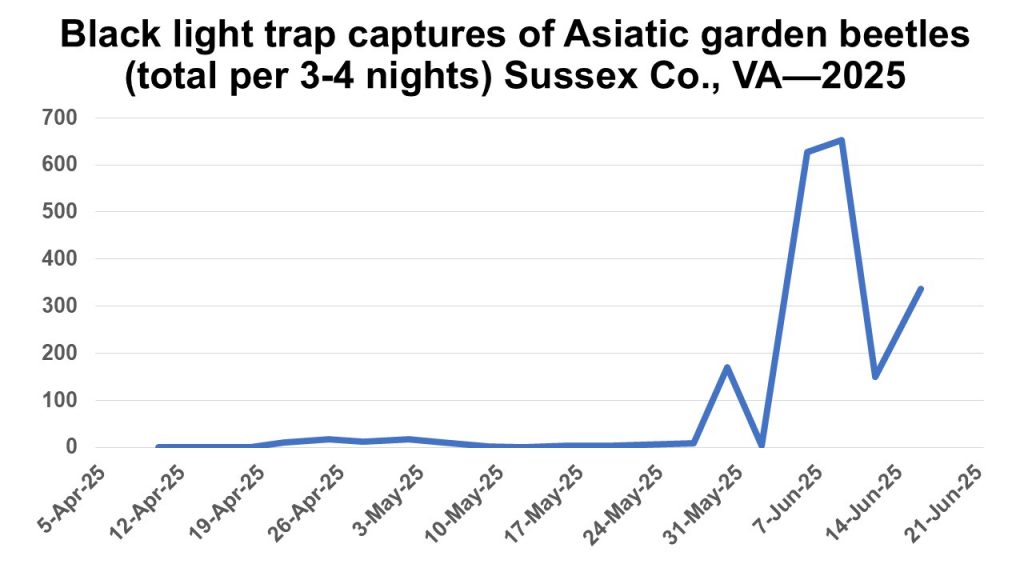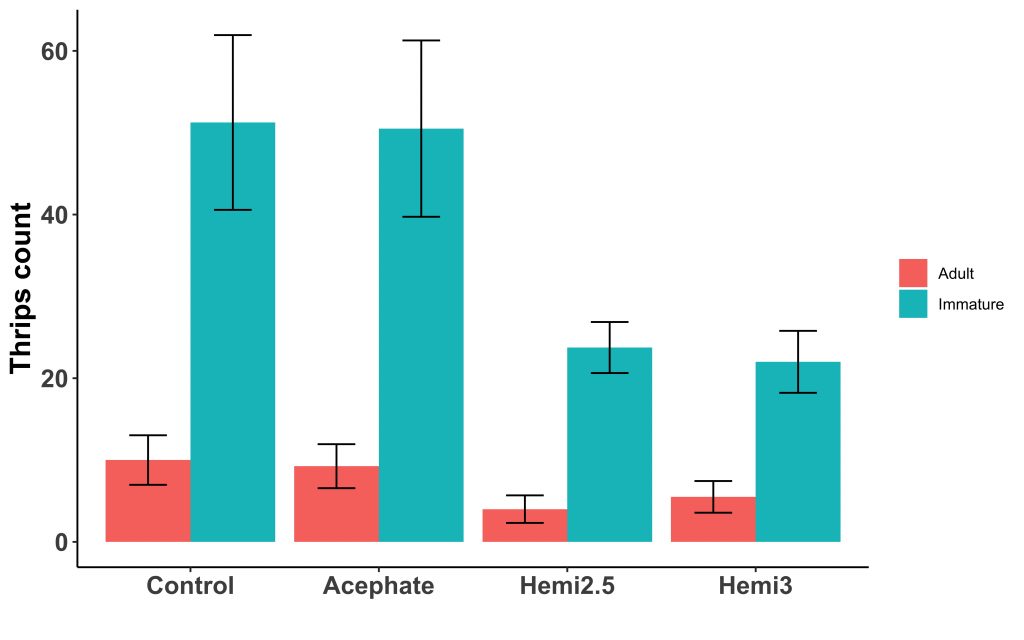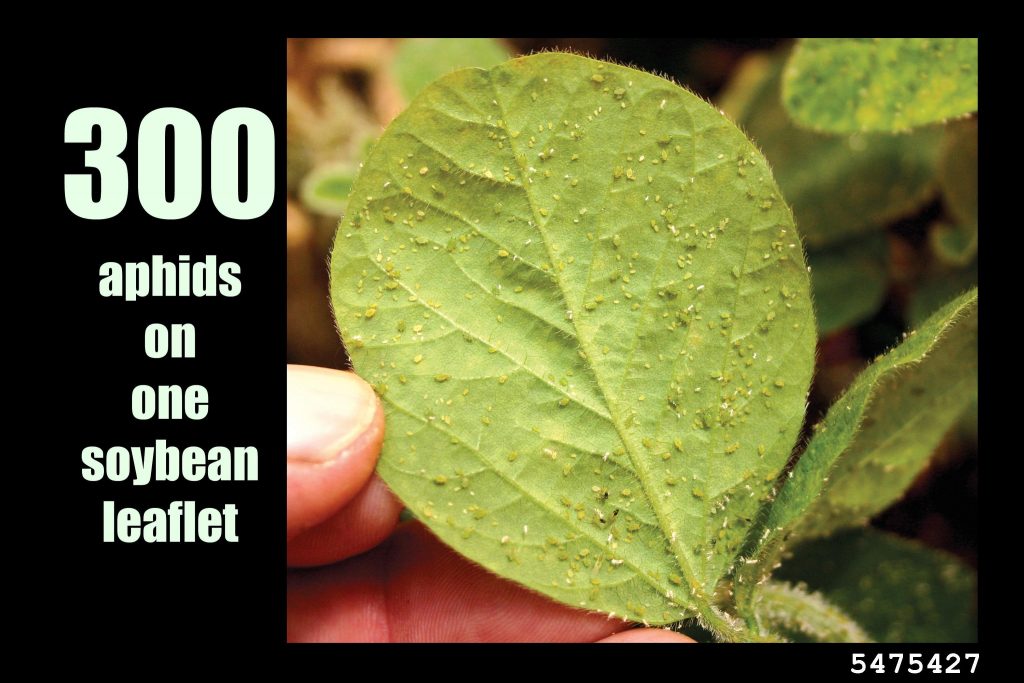Asiatic garden beetle numbers in our Sussex County, VA black light trap dropped this week, with 60 adults total caught in the past 3 nights (Figure below).

June corn earworm moth captures in our pheromone trap monitoring network are provided in this Table. Please note that new locations across Virginia have been added this week.
More locations across Virginia have been added to the corn earworm moth pheromone trapping network. Thanks to the many Virginia Cooperative Extension Agents and Interns (and others) who are monitoring these traps. Here is the Table (it is a pdf file; you’ll need to zoom in). Reporting Virginia counties now include: Augusta, Caroline, Dinwiddie, Essex, Greensville, Isle of Wight, King George, Lancaster, Northampton, Northumberland, Rockbridge, Rockingham, Southampton, Stafford/King George, Suffolk, Surry, Virginia Beach, and Westmoreland. Some high numbers were reported in Stafford/King George (one trap averaging 25 per night) and Virginia Beach (one trap averaging 17 per night).
The entomology program at the Tidewater AREC has continued to monitor Asiatic garden beetle adults in our black light trap. The population peak in early June 2025 (see Figure) is very similar to what we saw in early June of 2024. Much of our cotton now has enough growth on it that some defoliation can be tolerated–but similar to thrips, I would recommend keeping an eye on anything that has not reached 4-5 true leaves.

Thanks to the Virginia Soybean Board and all the participating Agents and others who have allowed us to add more pheromone traps to Virginia’s corn earworm monitoring network. Some locations reported zero’s but others such as Caroline and King George had high captures. Here is the Table along with acknowledgements.
With funding support by the Virginia Soybean Board, the Tidewater AREC entomology program (led by Dr. Tim Bryant), along with collaborating Virginia Cooperative Extension Agents and Interns, has expanded our Helicoverpa zea (corn earworm/bollworm) pheromone trap monitoring network. Because corn earworm populations vary across the state, knowledge of local moth flights can better inform growers when to scout fields, use insect thresholds, and make the best management decisions for their crops. Here is the Table Numbers in the table represent variable numbers of days between trap checks (most are 3 or 4 nights).
In Dr. Tom Kuhar’s Advisory from May 28, 2025, he discusses high catches of corn earworm moths in Halifax and Northampton Counties, and in Delaware. We saw high catch numbers from Stafford and Caroline Counties this week. We’ll continue to keep you up to date on corn earworm flights across Virginia and expect many more counties to begin issuing reports.
On Monday, May 26 the Tidewater AREC entomology team collected tobacco thrips from cotton throughout southeastern Virginia. These populations were sent to the University of Tennessee where they were tested in the lab for susceptibility to acephate, spinetoram (Hemi SC or Radiant), and dicrotophos (Bidrin). Across all the sites, the results were very consistent with;
75-79% mortality with acephate
100% mortality with spinetoram
47-50% mortality with dicrotophos
We would classify this as tobacco thrips having reduced susceptibility to acephate in southeastern Virginia. Acephate resistance was also previously confirmed in northeastern North Carolina, just across the state line. This year we have found a high proportion of flower thrips, which are harder to kill with acephate, and now have confirmed that acephate has reduced efficacy for tobacco thrips. If you still plan to make a foliar thrips application, or are making a second application after a previous acephate application, Hemi SC (spinetoram) should be considered for more effective control. See this previous blog post for more details on the importance of timing your foliar application for maximum economic return.
We’d like to thank Sebe Brown at the University of Tennesee and his team for running the lab tests and the Virginia Cotton Board for sponsoring this research.
It has been a cool and wet start to the cotton season in southeast Virginia, and growth is slow. With a slow start to the season some folks are considering a second foliar application for thrips management. There are a couple key things to consider…
The first thing to consider for effective thrips management is timing
The most consistent return on investment comes from a foliar application early in the first true leaf stage. An application at the second leaf stage sometimes pays off, which is more likely to be the case with our current growing conditions. If cotton reaches the three or four-leaf stage, foliar applications made for thrips rarely pay off.
The next consideration is what insecticide to chose.
One of the most commonly used products to control thrips with a foliar spray is acephate. There are two thing to consider when using acephate; 1) western flower thrips are not as susceptible to acephate as tobacco thrips, and 2) acephate resistance has been documented in tobacco thrips in northeastern North Carolina, just across the state line from us in southeastern Virginia.
Populations of western flower thrips have been high so far in southeastern Virginia.
In several trials at the Tidewater AREC in Suffolk, we found around 80% western flower thrips in a foliar insecticide trial. Additionally, collections made from grower fields throughout Suffolk and Southampton counties on May 23 averaged 73% western flower thrips. While most fields did have a majority of western flower thrips, it is important to note that it varies between fields even across a relatively small area, and some sampled fields had a larger proportion of tobacco thrips. A table of thrips collections from May 23 can be found below. Each row represents a sample of five cotton plants in a field in Suffolk or Southhampton county.
| Field | Tobacco thrips | Western flower thrips | % Western flower thrips |
| #1 | 2 | 6 | 75% |
| #2 | 2 | 13 | 86% |
| #3 | 1 | 4 | 80% |
| #4 | 4 | 23 | 85% |
| #5 | 11 | 3 | 21% |
| #6 | 1 | 9 | 90% |
| #7 | 1 | 8 | 88% |
| #8 | 4 | 4 | 50% |
In the foliar insecticide test at the TAREC, acephate (at 3 oz/ac) did not provide better control than not treating with these high populations of flower thrips. Hemi SC (spinetoram), provided good thrips control at both the 2.5 and 3 oz rates. Hemi SC is the same active ingredient found in Radiant and is available for use in Virginia and the Carolinas this year for thrips suppression. It is important to mix Hemi SC with a non-ionic surfactant or with an herbicide which already contains a surfactant, to get good thrips control.

If you are using acephate, you should carefully monitor the performance of the application in your field. If you are not satisfied with the performance of an acephate application, the cotton growth stage and the growing conditions at that time should be assessed before considering a second application. If a second application is made, Hemi SC should be considered for more effective control and to rotate the insecticide mode of action. Bidrin should not be used for a second application after acephate, as these two insecticides are the same mode of action.
Both acephate and spinetoram can be washed away by rain up to 8 hours after application (or possibly longer), but acephate is slightly less susceptible to being washed away when comparing the two. However, some protection from a foliar application is better than none under current conditions, which are expected to extend through this weekend.
As a reminder, if you are planting Thryvon cotton, it provides excellent thrips control and does not need a foliar application. If you have any thrips questions contact Tim Bryant (757-621-8804, btim2@vt.edu), field crop entomologist at the TAREC in Suffolk, VA.
First, I would like to introduce myself. I am Tim Bryant, the new assistant professor of entomology and extension specialist at the Tidewater AREC, in Suffolk, VA. I did my master’s degree here at the TAREC under Dr. Sally Taylor, and I am excited and grateful for the opportunity to come back and work with the farming community in Virginia. I am also looking forward to continuing to provide updates on this platform as regularly as we have updates to provide. Now, on to a quick update from my first few weeks on the job…
Soybean aphids have been reported in Mecklenburg and Prince George counties (First reports 8/28). Aphids can reproduce asexually, and are capable of rapid population growth under the right conditions, so close monitoring is important. Our threshold for managing soybean aphids is 250 per plant at R4 (full pod) or prior, and 1000+ at R5 (beginning seed) and beyond. The below image shows 300 aphids on a single leaflet as a point of reference (Photo credit: Roger Schmidt, University of Wisconsin-Madison, Bugwood.org). There is likely to be multiple developmental stages of aphids present at one time, and early stages are very small.

There are a couple key considerations for managing aphids; 1) they are highly susceptible to population crashes from natural enemies or weather events, and 2) broad-spectrum insecticide applications (i.e. pyrethroids) may kill aphids, but also the afore-mentioned beneficial insects. Eliminating beneficials can potentially flare up spider mites or other pests later on. If you think you may have an aphid problem, scout several areas of the field to estimate the number of aphids per plant and pay close attention to the number of beneficial insects present. Where we scouted for aphids, there were also large numbers of lady beetle adults and larvae, which are excellent aphid predators. If you reach the aphid threshold, sample again in 5-7 days to ensure the population has not crashed. Narrower spectrum insecticides (e.g. sivanto) may preserve some beneficial insects if an application for aphids is made. See our pest management guide (beginning on page “4-62”) for more details on labeled products, application rates, etc.
The below image shows a lady beetle larvae, which were found in abundance along with the aphids we are reporting on here, feeding on an aphid (Photo credit: Winston Beck, Iowa State University, Bugwood.org).
